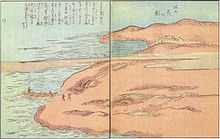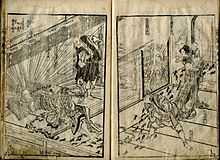E-hon

E-hon or Ehon (絵本) is the Japanese term for picture books. It may be applied in the general sense, or may refer specifically to a type of illustrated volume published from at least the mid-Edo period onwards, often as chapter-books in series. In English, it is this second usage which is the more common, i.e.: Japanese picture-books of a specific format (and produced in the traditional manner).[citation needed]
E-hon were traditionally produced as woodblock prints on thin washi paper (printed on one side only, then folded in half, creating a "leaf" with printing on both sides), bound together (right-to-left page order) with a simple external threaded binding; typically black (sumi) ink on white paper, often with polychromatic cover designs & sometimes with (usually more limited) internal colouring. Extremely popular during the late Edo-Meiji era. The modern Japanese manga format was created as a combination of ehon chapter-books with western-style comic books.
E-hon production was a significant part of the Japanese publishing industry (particularly) during the 19th century; most Japanese woodblock print artists of the period produced e-hon designs (often in large quantities), as commercial work.[1] However, the publication of e-hon dates back as far as the Muromachi Period.[2]
Toward the end of the 19th century, e-hon chapter-books were eclipsed in popularity by the new "western" concept of literary magazines. These were larger books which contained more, and a wider range of material per-issue, but usually fewer pictures (measured on a text-to-images ratio). They often used more modern printing methods; the increase in production costs was offset by increased efficiency, larger-scale printing and distribution, and the introduction of advertising. Typically, a magazine would include one large folded, polychrome illustration referencing some "feature" story in the volume, as a frontispiece. Such pictures, woodblock-printed in colour, are known as kuchi-e. The new format also absorbed most of the remaining talent and market for ukiyo-e style prints.
 Akaei-no-uo from the Ehon Hyaku Monogatari - circa 1841 |
 An image from the e-hon series Raigo Ajari Kaisoden/Priest Raigo's Mysterious Rat(s); story by Kyokutei Bakin, this edition was illustrated by Katsushika Hokusai - circa 1808 |
| Wikimedia Commons has media related to E-hon. |
References
- ↑ "NYPL Digital Gallery | Explore All Collections". Digitalgallery.nypl.org. Retrieved 2010-10-06.
- ↑ "Dharma Wonder Boy". World Digital Library. Retrieved 24 May 2013.
| ||||||||||||||||
